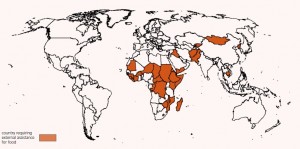According to the European Union (EU), the Sahel region of Africa could suffer a localized food crisis next year. From an article in the Guardian:
Africa’s Sahel region faces a severe food shortage next year because of erratic rainfall and localised dry spells, the EU commissioner for humanitarian aid crisis response has warned.
Kristalina Georgieva said investing in the Sahel now was not just the ethically and morally right thing to do, but would be less expensive than waiting for disaster to strike, as was the case in Somalia.
Seven million people are already facing shortages in Niger, Chad, Mali, Mauritania, Nigeria and Burkina Faso, with major shortfalls in food production in many areas. The figures point to a massive problem of food availability next year, according to the European commission.
The article then goes on to discuss how now is the time to act if we are to prevent a food crisis in the Sahel. This is especially true if aid takes the form of food aid, given how it for food aid to get to where it is going.
Here is a map culled from the FAO’s December 2011 Crop Prospects and Food Situation (link opens a .pdf). The countries in red are those most in need of food assistance. It indeed looks like the need for food assistance is concentrated around the Sahel and parts of Central Africa.
